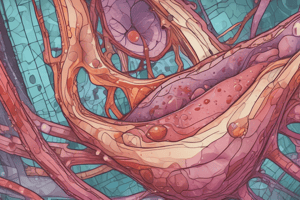Podcast
Questions and Answers
What is the result of the healing process in the body?
What is the result of the healing process in the body?
- Replacement of dead or damaged cells with new cells of a different type
- Replacement of dead or damaged cells with healthy cells of the same type (correct)
- Transformation of dead or damaged cells into a different cell type
- Elimination of dead or damaged cells without replacement
What is the main advantage of repair by regeneration?
What is the main advantage of repair by regeneration?
- It restores the organ to normal functioning capabilities (correct)
- It leads to the formation of scar tissue
- It is less energy-efficient than repair by fibrosis
- It is a faster process than repair by fibrosis
What is a necessary condition for an injury to be healed by regeneration?
What is a necessary condition for an injury to be healed by regeneration?
- The presence of fibroblasts
- The presence of a basement membrane
- The absence of ischemia and toxins
- The ability of the destroyed cell type to replicate (correct)
What guides the growth of cells during the healing process?
What guides the growth of cells during the healing process?
What is the term for the process of replacement of damaged tissue by fibrous connective tissue?
What is the term for the process of replacement of damaged tissue by fibrous connective tissue?
How are cells of the body divided according to regenerative capacity?
How are cells of the body divided according to regenerative capacity?
Which type of cells have the ability to regenerate after injury as long as the pool of stem cells is preserved?
Which type of cells have the ability to regenerate after injury as long as the pool of stem cells is preserved?
Which cells continue to multiply throughout life under normal physiological conditions?
Which cells continue to multiply throughout life under normal physiological conditions?
What happens to the ability of permanent cells to proliferate around the time of birth?
What happens to the ability of permanent cells to proliferate around the time of birth?
In which type of cells is the replication activity minimal?
In which type of cells is the replication activity minimal?
How are injuries in organs composed of permanent cells repaired?
How are injuries in organs composed of permanent cells repaired?
When does the combination of regeneration and fibrosis occur in the repairing process?
When does the combination of regeneration and fibrosis occur in the repairing process?
Flashcards are hidden until you start studying
Study Notes
Healing Process
- The healing process begins early in the inflammatory process and results in repair of the injury by replacement of dead or damaged cells with healthy ones.
- The body uses two distinct processes in the repair:
- Regeneration: replacement of injured tissue with cells of the same type
- Repairing and Fibrosis (repair = fibrosis): replacement of damaged tissue by fibrous connective tissue
Importance of Regeneration
- It is most advantageous for repairs to occur by regeneration because this will restore the organ to normal functioning capabilities
- Most injuries are repaired by a combination of these two processes
Conditions for Regeneration
- The cell type that was destroyed must be able to replicate (Replicative activity)
- The damaged cells can be proliferated from mature stem cells (Regenerative capacity)
- The presence of a basement membrane or a collagenous network made by fibroblasts that will guide the cells' growth
Cell Classification Based on Regenerative Capacity
- Labile cells: continuously being lost and replaced by maturation from stem cells; can readily regenerate after injury (e.g., surface epithelial cells of the epidermis, alimentary tract, respiratory tract, urinary tract, vagina, cervix, and endometrium)
- Stable cells: decrease or lose their ability to complete their maturation after adolescence, but retain the capacity to multiply and proliferate in response to stimuli throughout adult life (e.g., parenchymal cells of organs like liver, pancreas, kidney, adrenal, and thyroid)
- Permanent cells: considered to be terminally differentiated and non-proliferative in postnatal life; lose their ability to proliferate around the time of birth (e.g., neurons, skeletal and cardiac muscle)
Repair Process
- Injuries in organ or tissue composed of permanent cells will be repaired by fibrosis
- Injuries in organs composed of labile or stable cells are repaired either by regeneration or by a combination of regeneration and fibrosis depending on the extent of the injury
Studying That Suits You
Use AI to generate personalized quizzes and flashcards to suit your learning preferences.




